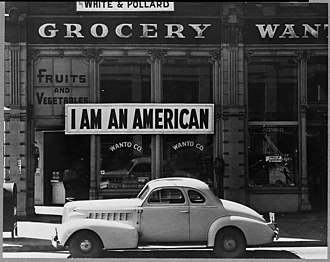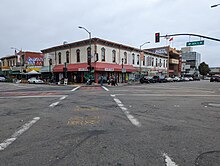Chinatown, Oakland, California
[4]: 13 Many Chinatowns in America have added a formal entry gate (Paifang) since 1970, marking the entrance to the district, but Oakland has not; aside from the architecture, bilingual street signs are distinctive features of the neighborhood.The northern portals of the Posey and Webster Street Tubes, which carry traffic underneath the estuary between Oakland and Alameda, are on the edge of Chinatown.[7] In the early days, the Chinese Methodist Church held worship service and Sunday School.The early days of the church was sustained by courageous workers, both Chinese- and American-born as there were strong anti-Chinese sentiments in California at this time.Chan Hon Fun was the pastor from 1900 to 1909 and established the church's current location in 1905 at 321 8th Street Oakland, CA 94607.A mixed use complex built by Hong Kong investors in 1993,[4]: 13 this plaza with a central fountain with seating is often viewed as the center of Oakland Chinatown.The Masuda family had posted a large "I Am An American" sign outside their Oakland grocery store, Wanto Company, at 8th and Franklin streets which was photographed by Dorothea Lange.Chinatown saw much steady development during the 1980s and 1990s as Chinese American merchants relocated from San Francisco to Oakland, and due to increased immigration from mainland China, Hong Kong, Vietnam, Cambodia, and Thailand.Consequently, many languages and dialects can be heard, including Cantonese, Cebuano, English, Spanish, Chiu-Chow, Ilocano, Japanese, Khmer, Khmu, Korean, Lao, Malay, Mien, Tagalog, Taiwanese, Thai, Toishan, and Vietnamese.In 1907, a Chinese Theater at 9th and Franklin streets opened which could seat 500 people and had a company of 30 full-time actors from China.In 1981, it moved to a storefront among Chinatown shops and food stores in the 15 story City Center Plaza condos building at 449 9th Street at Broadway becoming the Asian Branch Library.Hoseman Tracy Toomey who died in the line of duty on January 10, 1999 in a 2-story building collapse after responding to a 6-alarm fire on upper Broadway.Weekday and everyday commerce in the area creates thousands of peak period private automobile trips daily and resulting air pollution adversely affects the health of the neighborhood's elderly residents.This effectively eliminated any possibility of the lost art of the alternating "zipper" merge, initially through signs and later updated with flex posts added around 2014.The volume of automobile traffic travelling away from the core of Chinatown on 7th Street towards these freeway connections remains heavy and unrelenting, resulting in numerous instances of drivers striking pedestrians.Currently, motorists must travel along busy Chinatown streets between the tubes and the freeway, and a more direct connection will reduce conflicts between cars and pedestrians.The insurance actuarial theory behind this market practice purports that drivers residing or "principally garaging" their cars in a certain area face a greater loss and accident ratio.Oakland Chinatown is served by several AC Transit bus lines which run on 7th, 8th, 11th, 12th, Broadway, and Franklin Streets, including Line 1T (Tempo) bus rapid transit service along 11th/12th, with Chinatown stops straddling Madison,[41] Harrison, and Broadway."To serve and advocate for the medically underserved, including the immigrant and refugee Asian community...", is an integral part of their mission statement.








Neighborhood of OaklandOaklandCaliforniaAlamedaSan Francisco Bay AreaTime zoneArea code12th Street Oakland City CenterLake MerrittOakland, CaliforniaChineseChinese AmericanAsian AmericanSan Francisco's ChinatownJapaneseKoreansFilipinosSoutheast AsiansVietnam WarAsian languagesdialectsInterstate 880Oakland Museum of CaliforniaDowntownLaney CollegePaifangbilingualstreet signsPosey and Webster Street TubescommercialInternational BoulevardOtis GibsonWomen's Missionary Society of the Pacific CoastOakland Asian Cultural CenterpagodaSouthern Pacific 2467Wilma ChanOakland ChinatownChinese immigrantsCentral Pacific RailroadFirst transcontinental railroadCoolieestuaryTelegraphSan Pablo AvenueYellow perilSan Francisco BayshrimpSan RafaelTemescalLake ChabotlaundrygardenershouseboysvegetablepeddlersChinese Exclusion ActDorothea LangeWest Oaklandattack on Pearl HarborJapanese AmericansinternmentJapantown1906 San Francisco earthquakebachelorWorld War IIBay Area Rapid TransitLake Merritt stationHong KongVietnamCambodiaThailandChinese VietnameseChinese CambodiansTaishanesefortune cookieHispanic and Latino AmericansAfrican AmericansVietnameseKoreanFilipinoCambodianLaotianPolynesianCantoneseCebuanoEnglishSpanishChiu-ChowIlocanoTagalogTaiwaneseToishanChinese New YearDragon boat racesJack London SquareTreasure Island, CaliforniaMid-Autumn FestivalChinese operaCantonese operaBeijing operaOakland Public LibrarystorefrontAmy TanBen Fong-TorresBruce LeeDong KingmanFlower Drum SongThe World of Suzie WongCharles Goodall LeeChinese American Citizens AllianceFrank ChinFred KorematsuKorematsu v. United StatesLew HingMarch Fong EuMatt FongMaxine Hong KingstonThe Woman WarriorJoe Shoong2022 Oakland mayoral candidateRodney YeeWendy YoshimuraWilliam WongUnited States SenateLaphonza Butler